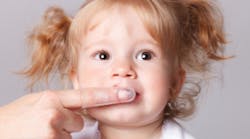Hygiene Message in a Bottle Mailbag: Happy visits for patients under age 3
The Hygiene Message in a Bottle Mailbag is a monthly feature of the e-newsletter, Pearls for Your Practice: The Product Navigator. Each month, Colleen Olson, RDH, BBA, the editorial director of the Hygiene Product Navigator, will answer reader-submitted questions to help you navigate your dental hygiene product decisions (and more!). This month, she shares her recommendations for "happy visits" with patients under the age of three.
In school I didn’t see any patients under the age of three. What are we hygienists supposed to do for patients who come in for exams before the age when we could actually do a prophy?
Answer:
Great question! I didn’t see any babies or toddlers in school either, so there was a little bit of a learning curve when I started working in private practice. Things may be done differently at a pediatric specialty office, but in our general family practice, this is how a typical “happy visit” will go before the doctor comes in to do his exam.
After addressing any concerns the parent has, I will usually ask about oral hygiene habits. If the baby has teeth that have erupted, do the parents try to brush her teeth? Are they using any toothpaste? Does she go to bed with a bottle or sippy cup?
I always recommend that parents begin brushing their baby’s teeth as soon as possible to help the baby adjust to tooth brushing. For this same reason, depending on the age of the child, I may show them how the air and water, prophy cup, and saliva ejector work at the dental chair. If anything, demonstrating these devices can prepare the child for sounds and sensations they may experience at a subsequent visit. Sometimes we will spray water into a cup and suck it out with a saliva ejector, or I will run the rotating prophy cup over their fingernail to demonstrate what the cup feels like when its moving. If parents report having success with tooth brushing, then I use a soft toothbrush to brush the child's teeth as well.
When it comes to toothpaste, the American Dental Association (ADA) and American Academy of Pediatrics (AAP) updated their recommendation in 2014 and suggest fluoride toothpaste for all patients who have erupted teeth. Their websites state that, for patients under three years of age, a tiny smear of fluoridated toothpaste the size of a grain of rice should be used to brush the teeth twice daily from the time the teeth begin to erupt. The recommendation changes to a pea-sized amount for children aged three to six. (1,2) Of course, children should start spitting out excess toothpaste as soon as they are old enough to do so. According to the ADA’s Council on Scientific Affairs, “Approximately 25% of children have or had cavities before entering kindergarten, so it’s important to provide guidance to caregivers on the appropriate use of fluoride toothpaste to help prevent their children from developing cavities.” (3) The newest guidelines aim to ensure the benefits of fluoride toothpaste while limiting the possibility of fluorosis.
When it comes to drinks before bed, we always recommend plain water between tooth brushing and bedtime. It’s surprising to me how many parents still put toddlers to bed with a sippy cup of milk or juice despite knowing better, but I try to be nonjudgmental and reinforce the idea that a better alternative is water.
At our office, the main focus of exam appointments for children under three is to get them used to the sights, smells, and sounds of the dental office, to answer any questions the parents may have, to provide home care and oral hygiene instruction, and to make sure the child has a good experience at our office. If a child is having a bad day or is generally uncooperative, we don’t ever force anything. We want the child to leave our office unafraid and willing to come back and try again another time. The last thing we want to do is create dental anxiety in our newest and youngest patients.
I hope this gives you an idea of some things we can do to help our patients before they reach an age where they can cooperate with us for a full prophy.
References
1. Fluoride and Infant Formula FAQ. American Dental Association website. http://www.ada.org/en/public-programs/advocating-for-the-public/fluoride-and-fluoridation/recent-fluoridation-issues/infant-formula-and-fluoridated-water/fluoride-and-infant-formula-faq.
2. AAP Recommends Fluoride to Prevent Dental Caries. American Academy of Pediatrics website. https://www.aap.org/en-us/about-the-aap/aap-press-room/pages/AAP-Recommends-Fluoride-to-Prevent-Dental-Caries.aspx. Published August 25, 2014.
3. ADA Uses Fluoride Toothpaste to Fight High Cavity Rate in Children [news release]. Chicago, IL: American Dental Assocation; February 10, 2014. http://www.ada.org/en/press-room/news-releases/2014-archive/february/ada-uses-fluoride-toothpaste.
Editor's note: Do you have a question for Colleen? Is there a product you'd like to see her review? Or would you like to submit your own hygiene product article? Send an e-mail to [email protected]. You might just see it in the Hygiene Product Navigator! If you're not a Product Navigator subscriber, click here to sign up.
More reading
February 2017 | Electric toothbrush recommendations
January 2017 | New research on chlorhexidine as an irrigant for ultrasonic scaling
December 2016 |Relief for patients with root exposure and sensitivity
For the most current dental headlines, click here.
About the Author

Colleen Olson, RDH, BBA
Editorial Director
Colleen M. Olson, RDH, BBA, is an editorial director for the e-newsletter, Pearls for Your Practice: The Hygiene Product Navigator. She earned a bachelor's degree in business administration from Texas A&M University in 2008 and worked in sales for five years. She graduated from the Blinn College Dental Hygiene program in 2013. She is a full-time mom to Bonnie Grace and is currently a part-time hygienist in private practice in San Antonio, Texas. She enjoys spending time outdoors with her husband, Zach, and their families.


